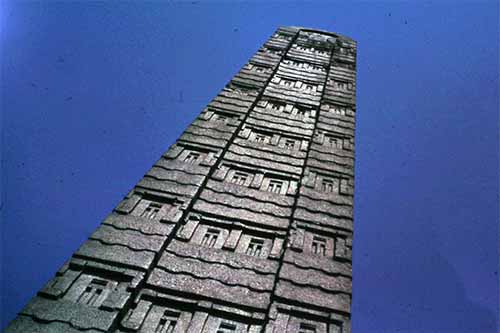About Axum City Ethiopia : Kingdom, Obelisks & Stelae

Large stone stelae rise to the sky in Ethiopia’s spiritual capital, where the Ark of the Covenant is said to be kept.
An African country in the Horn of Africa, Ethiopia is a land of noble peoples, unique animals and scorching deserts of lava and salt. From its red lands have arisen some of the most enigmatic kingdoms in history, legendary civilizations like that of the Aksumites who left a series of mysterious traces in Aksum, their ancient capital.
Kingdom of Aksum
Mention is made, for the first time, of this mysterious kingdom in an ancient document known as Periplus Maris Erythraei: in this travel diary, the author describes the kingdom of the Aksumites as a rich land ruled by King Zoskales , a cultivated tyrant and keen on literature. The Aksumite civilization reached such a level of sophistication that they circulated rare and valuable gold coins bearing the effigies of at least twenty different rulers. According to recent studies, the Aksumite civilization dates back to at least the 4th century BC, but we have not yet shed light on its origins.
To add to the confusion, the ancient official Aksumite language, Geez, used by the Ethiopian imperial court in documents until 1974 and still in use as the liturgical language of the Ethiopian Orthodox Church, dates directly to 2000 BC.
Obelisk of Axum facts

But there is one characteristic that makes this African civilization truly unique: giant stelae are carved out of blocks of granite that can still be seen by the dozen in present-day Axum; some are damaged on the ground, others stand out from 30 meters high. But until now, their meaning remains a mystery. Among those that are still standing, there is the so-called King Ezana’s Stela, 24 meters high; since 2008, the twin stele that Italy returned to Ethiopia has been replaced by its side. But the Great Stele of Aksum, whose collapse - according to legend - marked the end of the Aksumite Empire, was 33 meters high and it still lies today where the gods have dropped it. The Aksumite stelae have a unique style: their decorations seem to represent doors and windows, sometimes with decorations reminiscent of handles; they are always made in the hollow of the stelae themselves as if they had received plaques or precious effigies that no one has ever found.
One wonders about the nature of the stelae: it seems strange that they could have been simple funerary monuments because there are no corresponding tombs. Their style, which is more like that of a dwelling than that of a monument, is also a mystery. According to some calculations, the block of stone that constitutes the Great Stele must have weighed around 520 tons. We still cannot give a definitive answer as to how it was possible to move it over 4 kilometers - the distance between it and the quarries - and then erect it.
Aksumite civilization legends and mystery
But the huge granite stelae are not the only mystery of the ancient Aksumite civilization. According to the accounts of several travelers, it seems that the ground resonates underfoot, due to the countless tombs and cavities that riddle the area. Legends claim that the dense network of underground vaults - part of which is still unexplored - would conceal a passage leading into Arabia.
The mystery remains on the causes of the end of the mythical Aksumite civilization. Legends recorded in jealously guarded writings by nearby monks tell of a warrior queen called Gudit, possibly pagan or of Jewish origin, who destroyed the city by burning it down in one night. Gudit killed the last Aksumite ruler and cut down a large number of stelae. The only thing we can be sure of is that the last remaining obelisks - the smallest that do not bear an inscription - are kept in a dedicated park. The ultimate traces of a majestic and secret people, buried in the sands of time.
Aksum today
Aksum is today the destination of great pilgrimages: it is considered the holiest city of all the cities of Ethiopia. The Orthodox Church affirms that, in the Church of Our Lady of Sion, the mythical Ark of the Covenant is preserved: the chest of supernatural powers containing the Ten Commandments of Moses. It is unfortunate that no one can observe or touch it except for the church keeper - the only one elected to have this privilege - who watches over it day and night, all his life.









































































































































































































































































































































